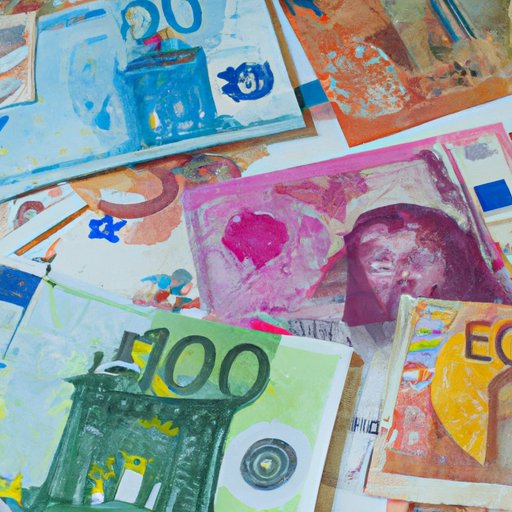
Introduction
Money is an essential part of our daily lives, but have you ever wondered how it came into existence? How did we go from bartering goods to exchanging paper bills and coins? This article explores the fascinating history of paper money, from its invention to modern times, and its significant contributions to the evolution of economic systems.
A Brief History of Paper Money: From Its Invention to Modern Times
Paper money has been in use for centuries, with various forms and materials used throughout history. In the West, the earliest form of paper money can be traced back to medieval Italy, where credit notes, known as “certificates,” were used instead of coins.
However, it was not until the 17th century that the first true banknotes were issued by banks in Europe. In America, the first paper money was issued by the Massachusetts Bay Colony in 1690, with other colonies soon following suit.
Notable events and figures that influenced the evolution of paper money include the establishment of the Bank of England in 1694, which issued the first official British banknotes, and the adoption of the gold standard in the 19th century, which tied the value of paper money to gold.
In modern times, paper money has become the dominant form of currency worldwide, with banknotes and coins issued by governments and central banks.

The Surprising Origin of Paper Money: Unearthing the Roots of Our Monetary System
The need for money goes back thousands of years, with various forms of currency used throughout history, including shells, beads, and precious metals such as gold and silver.
The transition from precious metal currency to paper came about due to a combination of factors, including the high cost of minting coins and transporting them, as well as the need for a more portable and convenient form of currency. With the introduction of paper money, the need for precious metals to back currency became less critical.
Forces that drove the development of paper currency include the growth of trade and commerce, which required more accessible forms of payment, and the rise of centralized governments and financial institutions that provided a stable framework for the issuance of currency.
It All Started with China: Tracing the Beginning of Paper Currency
The origins of paper currency can be traced back to ancient China, where notes made of mulberry bark were used as early as the 7th century. The first official banknotes were issued during the Tang Dynasty in the 9th century, which allowed merchants and traders to deposit money with a government bank in exchange for paper promissory notes.
During the Song Dynasty, the use of paper money became widespread, with government-issued notes becoming the primary form of currency in China. The use of paper money quickly spread to other regions, including Korea, Japan, and Europe, where various forms of promissory notes and banknotes were developed over time.
How Paper Money Revolutionized Trade and Commerce Throughout the Ages
One of the significant advantages of paper money is its portability, which allowed for more efficient trade and commerce. With the adoption of paper currency, merchants and traders no longer needed to carry large amounts of precious metals, which reduced the risk of theft and increased convenience.
However, there were also pitfalls associated with using paper money in commerce, such as counterfeiting, which became a prevalent problem during the early days of paper currency. Despite these challenges, the use of paper money continued to expand, with governments and financial institutions developing new strategies to combat fraud.
Historical examples of the role of paper money in shaping economic systems include the growth of the European colonial empires, which relied heavily on paper currency to finance their operations, and the establishment of modern banking systems, which used paper money as a component of their monetary policies.
The Birth of Modern Banking: Examining the Role of Paper Money in Financial Institutions
The introduction of modern banking systems had a significant impact on the development of paper money as a form of currency. With the establishment of centralized banks and the adoption of fractional reserve banking, banks were able to issue more money than they had in deposits, which allowed for greater economic growth.
The role of paper money in modern banking has evolved over time, with advances in technology leading to electronic payment systems, such as credit cards and online banking. Today, paper money remains an integral part of financial systems, but it is increasingly being replaced by digital currency, which offers even greater convenience and flexibility.
The Future of Money: Looking Back on the Creation of Paper Currency and Its Impact Today
The future of money is constantly evolving, with new technologies and payment systems emerging regularly. Digital currency, such as Bitcoin, has gained popularity in recent years, offering a decentralized alternative to traditional banking systems.
The rise of digital currencies raises new questions about the future of paper money and the role it will play in modern economic systems. While some argue that paper money will eventually become obsolete, others maintain that it will continue to play an essential role in on-the-go transactions and will remain a trusted form of payment for many years to come.
Conclusion
In conclusion, the creation of paper currency has had a significant impact on modern economic systems, allowing for the growth of trade and commerce on a global scale. From its origins in ancient China to its current use worldwide, paper money has undergone many changes and developments, shaping the course of history in the process.
The future of paper money remains uncertain, with digital currencies and new payment technologies continuing to emerge. However, regardless of what the future holds, it is clear that the impact of paper money on our daily lives and economic systems will continue to be felt for many years to come.




